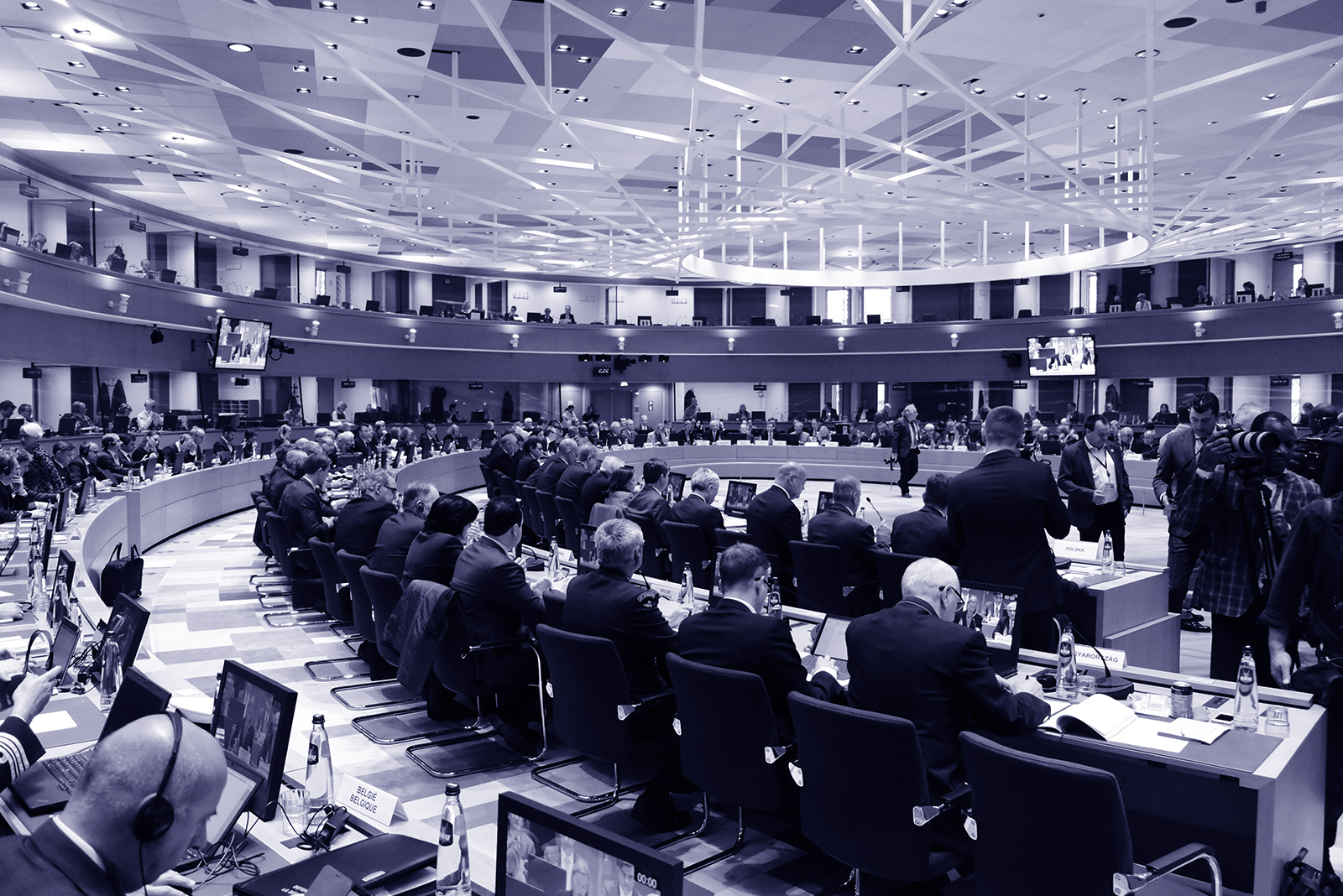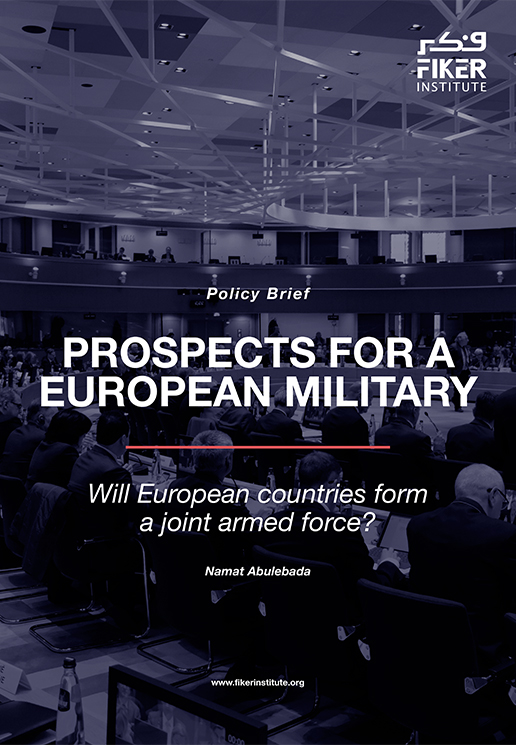
Prospects for a European Military
Last month’s North Atlantic Treaty Organization (NATO) summit put the question of burden-sharing for Europe’s security provision at center stage. While, ostensibly, transatlantic leaders appeared more unified around joint commitments to increase defense spending, the summit highlighted ongoing divergences between the allies. The gathering was notably short with only one working session scheduled to last a mere two and a half hours in an apparent effort to appease United States (US) President Donald Trump. The summit’s final declaration of only five short paragraphs suggest differing priorities. This underscores the growing need for Europe to take security matters into its own hands, through clear and tangible next steps, and prompts the question of whether it is time for a complete reorientation of European security.
Earlier this year, at the Munich Security Conference, Ukraine’s President Volodymyr Zelenskyy argued for the creation of an “armed forces of Europe,” saying “we can’t rule out that America might say ‘no’ to Europe.” This Policy Brief analyzes the feasibility of forming a potential European military and explores the challenges it could face in terms of current capabilities, organizational and structural issues, and the political hurdles to its establishment. It also examines what a European military would mean for the current transatlantic security architecture, and how it would be perceived by key international players.
THE ORIGINS OF THE IDEA
The idea of a European military has been floated since the 1950s. After the Second World War, France proposed a European force responsible for the security of the continent to counter the Soviet Union during the Cold War. In 1950, General Commissioner of the French National Planning Board, Jean Monnet, introduced a proposal for a supranational European defense organization. The initiative was initially meant to include six countries: France, West Germany, Italy, Belgium, Luxembourg, and the Netherlands. In 1952, the proposal, which became the European Defense Community Treaty, was signed by the six states, even gaining support from the United Kingdom (UK) and the US, though they did not sign it. However, the proposal eventually collapsed after the French National Assembly failed to ratify the Treaty. Since then, the idea of a European military has been spoken about without materializing through any concrete initiatives.
Over the years, several bilateral agreements aimed at strengthening cooperation on security matters have been signed by different European countries. These include a defense pact concluded by the UK and Germany in 2024, and more recently a security agreement between France and Poland in May 2025. On a European Union (EU) level, member states have adopted the Common Security and Defence Policy to provide a basis for security coordination and to position the EU as a global security actor. In 2004, the Union launched the EU Battlegroups, conceived as rapid response forces for peacekeeping and humanitarian tasks, comprised of troops from contributing member states. However the groups were never deployed and the role they were meant to fulfill is being replaced by the EU Rapid Deployment Capacity (RDC), which is supposed to be operational by this year. However, the RDC is designed primarily for crisis response and peacekeeping outside the EU, rather than as a standing military force for EU defense. To this day, no agreements regarding a full-scale European army exist – within our outside an EU framework – and security policy remains the purview of each sovereign state.
Over the course of the past decade, several European leaders have revived the idea of a European military. For example, in 2018, President Emmanuel Macron of France, as well as then Chancellor of Germany, Angela Merkel, expressed their support for a joint army at an EU level. Recently, especially since Russia’s full-scale war of Ukraine, and with the US shifting its priorities away from Europe’s security, several European leaders have emphasized the need for the continent’s security to be less dependent on the US. In a speech addressing the European Parliament in January of this year, Poland’s Prime Minister Donald Tusk echoed former US President John F. Kennedy’s famous line: “Don’t ask America what it can do for our security. Ask yourselves what we can do for our own security.” Similary, German Chancellor Friedrich Merz, shortly after his party won in Germany’s parliamentary election in February, stated that Europe must “achieve independence from the United States, step by step.” These statements highlight a rhetorical shift in Europe and signal a will to become more autonomous on matters of security and defense. But how this translates into tangible plans to restructure Europe’s security architecture remains to be seen.
THE FEASIBILITY OF A EUROPEAN MILITARY
Despite discussions of greater European military autonomy being back on the table, any practical steps to implement a joint European armed force would face significant institutional challenges. European countries strongly depend on military imports, highlighting a gap in European weapons manufacturing capacity. According to the Stockholm International Peace Research Institute (SIPRI), 53% of European arms imports came from the US between 2020 and 2024. To achieve more military autonomy, Europe would have to significantly increase European-produced armaments, including essential material needed to operate these arms. Beyond the origin of their weapons, European militaries also lack enough key arms to act independently in the face of an attack. According to a joint study conducted by Bruegel and the Kiel Institute for the World Economy, Europe would need “a minimum of 1,400 tanks, 2,000 infantry fighting vehicles and 700 artillery pieces” to provide credible deterrence against Russia. Reportedly, “this is more combat power than currently exists in the French, German, Italian and British land forces combined.” European countries would need to dramatically increase their stockpile of weapons to ensure war readiness in case of a possible Russian attack.
Faced with these challenges, European leaders have acknowledged the need to step up European arms manufacturing. On an EU level, the European Commission released a strategy in 2024 which focuses on “enhanc[ing] and support[ing] the Member States’ efforts to invest more, better, together, and European,” which would increase the “availability of defence products” in Europe and reduce countries’ reliance on weapons imports. President Macron has also emphasized the need to purchase European-made arms and encouraged his European counterparts to start buying local instead of from the US. However, to accelerate local arms manufacturing, European countries need to raise their defense budgets considerably. In March 2025, European Commission President Ursula von der Leyen described Europe as being in an “era of rearmament” and presented a plan to mobilize 800 billion euros (927.2 billion USD) for defense spending. This commitment is part of the ReArm Europe Plan/Readiness 2030, which aims to raise capital for European defense and facilitate joint procurements. According to estimates by Bruegel and Kiel Institute, Europe needs to increase its defense spending to at least 250 billion euros (289.7 billion USD), which amounts to 3.5% of European countries’ GDPs, in order to deter a possible Russian attack. At the NATO summit in June, European NATO countries pledged to increase their defense spending to 5% of their GDPs. However, European governments will likely face pressure over how this increase in military expenditure will be financed, with possible backlash over potential tax hikes, cuts to welfare spending, and increasing national debt burdens. This could empower populist far-right parties, many of which are skeptical of greater European integration and have criticized the financing of Ukraine’s war effort, and some of which have open pro-Russian tendencies. European leaders wishing to expand their militaries will need effective public messaging on the reality of the threat to tread the fine line between taking bold actions and keeping their populations on board.
Beyond exporting armaments to Europe, the US also has troops deployed on the continent. According to the United States European Command (EUCOM), there are 84,000 US soldiers stationed across Europe as of early 2025. The number has varied throughout the years, with the US having increased its troop deployment following the Russian invasion of Ukraine in 2022. These troops provide a deterrent, facilitate logistics, and conduct training exercises. While they add a substantial number to the standing armed forces on the continent, Europe’s joint national armies have a total of 1.47 million active-duty personnel which, if combined under a unified command, would reduce the need for US troop deployment to ensure European security.
Apart from military hardware and personnel, political will would likely present the most significant challenge to the creation of a European army with competing foreign policy and national security priorities having the potential to undermine collective action. Intra-EU tensions since the war with Ukraine have already exposed this dynamic. For example, Hungary and Slovakia have maintained friendly relations with Russia and have presented obstacles to collective European support for Ukraine. Similarly, competing foreign policy priorities could hamper a European military force in case of an attack. Moreover, several countries in Europe, including Ireland, Austria, Malta, and Switzerland, have enshrined neutrality as a principle of their foreign policy and are unlikely to join a European military which could undermine this stance. While some countries have recently taken steps away from neutrality following the war in Ukraine, for example with Finland and Sweden joining NATO and Austria and Switzerland participating in the European Sky Shield Initiative, some states are likely to oppose any joint military project on principle. For countries to come together in a joint European military, they would need aligned threat perceptions to prevent competing national security interests from acting as spoilers.
There is also the question of who would lead efforts to establish a European military, and which countries would stand to influence it. For purposes of cohesion, there would need to be a unified center of command, possibly following a model similar to NATO’s. To ensure interoperability, the European militaries would also need to conduct regular joint drills and military training sessions. For a European military to effectively replace the US’ role in providing security guarantees for Europe, it would have to include the major European economic and military powers, including France, the UK, Germany, and Italy. As Europe’s only nuclear-armed states, France and the UK in particular would be central to providing a nuclear umbrella in the absence of the US. It is unlikely that any of these countries would cede decision-making powers on issues of national security to a supranational army unless they perceived themselves as holding significant sway over it.
IMPLICATIONS OF A EUROPEAN MILITARY
A European military would put the existing transatlantic security architecture in uncharted territory. For decades, NATO has been the guarantor of peace and security in Europe. In the past, many, especially in the US, have opposed the idea of creating of a European military, arguing that it would overlap with NATO’s duties or could undermine the transatlantic alliances’ efforts. However, a stronger and more autonomous Europe could strengthen NATO and make it a more equal organization with Europe sharing more responsibility with the US. For a European military to effectively complement NATO, the US would likely have to be on board. The shift in US priorities away from European security, as explicitly stated by US Defense Secretary Pete Hegseth at a meeting of the Ukraine Defense Contact Group in February, and as shown by President Trump’s actions since his second inauguration, could signal the administration’s amenability to letting Europe take the lead on its security. However, the stance of future US administrations on plans for a European army would also affect its viability.
Another key player in transatlantic security is Canada. In June, Canada signed a defense pact with the EU in an attempt to move away from relying on the US. The agreement pushes for the cooperation between the EU and Canada to support Ukraine and enhance interoperability between Canadian and European forces. Canadian Prime Minister Mark Carney also expressed his hopes for Canada to sign on to the ReArm Europe plan. Canada could thus be open to the creation of a European army if Ottawa stands to benefit from enhancing military relations with Europe.
Finally, Russia’s possible reaction could have significant implications for the undertaking. Based on precedent, Russia would most likely view the creation of a Europe an military as a major provocation and a threat to its own security. In response to its assumption that Ukraine was close to joining NATO, Moscow used NATO expansion as a pretext to launch its invasion of the country in 2022. Furthermore, Russia instantly rejected the idea of stationing European peacekeeping troops in Ukraine. The creation of a European army could lead to a further escalation of tensions between Russia and Europe, possibly even a direct confrontation.
CONCLUSION
With European security directly threatened by an emboldened Russia and a US administration that has taken a step back from the continent, the time could be ripe for a fundamental reconsideration of Europe’s security architecture. These circumstances have left Europe in a precarious position, however, they could also pave the way for a more resilient and autonomous Europe. As past attempts have shown, the creation of a joint European military faces significant challenges. However, European countries have already started taking active steps to enhance local military capabilities and increase financing for rearmament. The principal hurdle is likely European governments’ and the public’s collective political will to cede sovereignty on key national security issues.
European security has always been based on, and dictated by, the whims of the US administration of the day, placing Europe in a precariously dependent situation. However, Europe’s polarized political climate will create domestic pressures for leaders seeking to expand their militaries’ roles and possible wrangling over who would lead a supranational reorganization of security could undercut joint efforts. It remains to be seen how European countries will respond to the current geopolitical realignments and whether they will seek to go beyond joint military financing plans to re-envision what European security would look like with a joint European armed force.
The statements made and views expressed are solely the responsibility of the author, and do not represent Fiker Institute.

